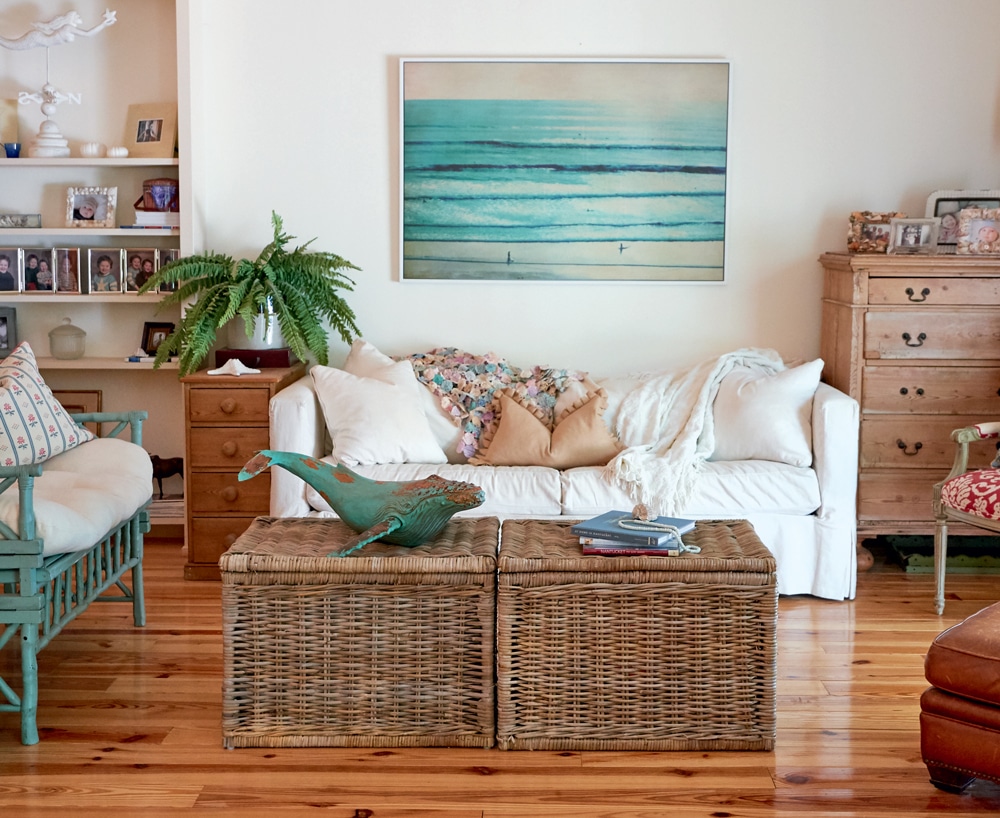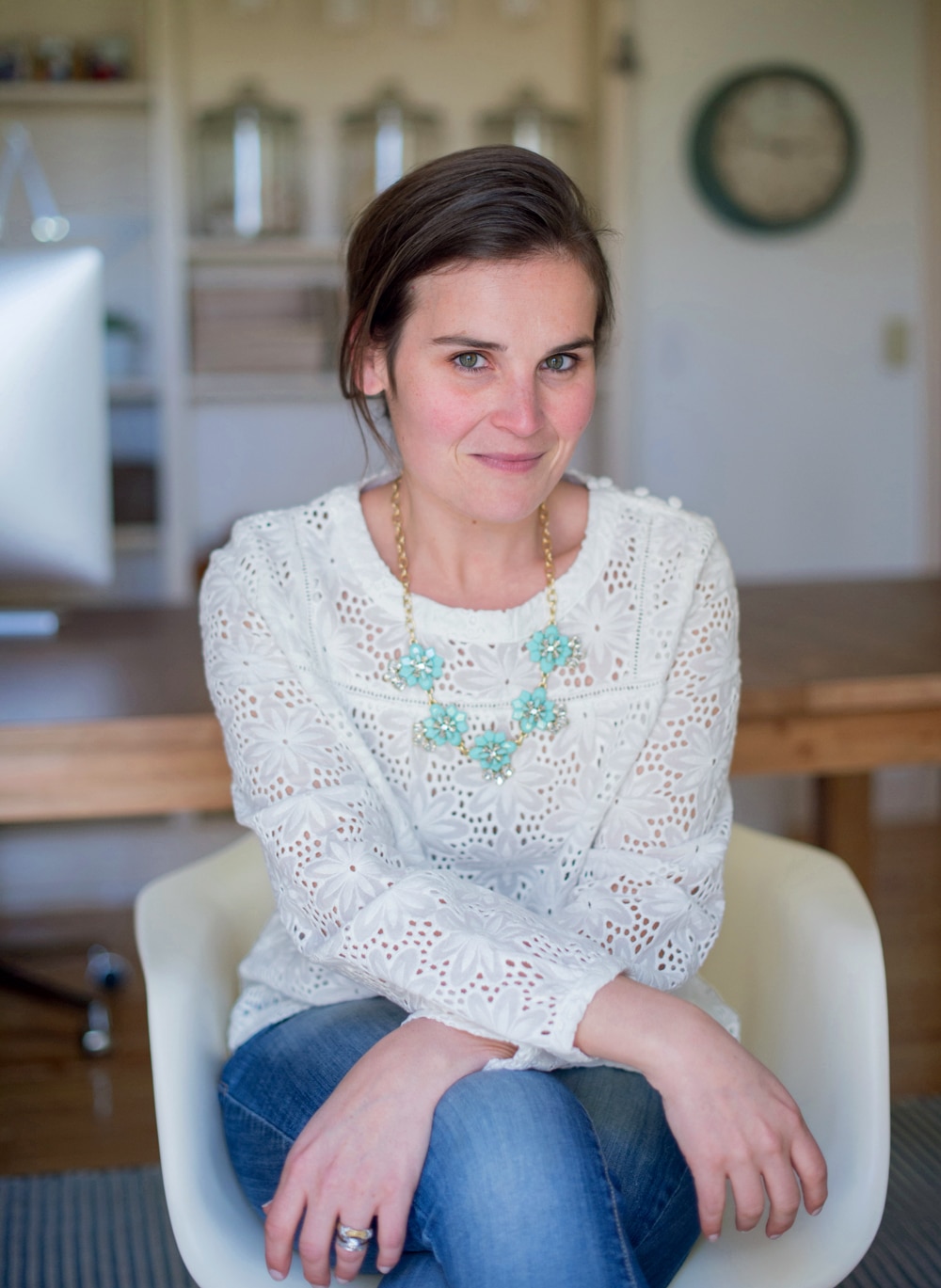Sara Fitz’s Ocean-Inspired Maine Cottage


Photo Credit : Mark Fleming
“Nantucket is just in me,” says Sara Fitzgerald O’Brien, as we drift from the living room to her art studio, in the home she shares with her husband, Miles, and their boys, Everett, 8, and Oliver, 6, in York, Maine.
The sea feels tangible here, the mood like quiet water at twilight. Foamy color washes the walls; furnishings flash pale turquoise, ocean blue. Bleached pine cupboards and tables—antique chunks of them—are strewn about like driftwood. Sea creatures would not be out of place here.
It’s easy living the beach dream when your home is actually on a beach. Fortunately, even if it’s not, there are ways to get around that. This slice of ocean calm is, in fact, a 10-minute walk from the water—although Long Sands Beach is visible seasonally through plastic binoculars secured to the poop deck of the boys’ wooden pirate ship in the backyard. “We didn’t even know there was a water view when we bought this house,” Sara says. “In the morning, Miles and I come out here and we just smell the salt air. The boys look at us like, what are you doing?”

Photo Credit : Brea McDonald
Therein lies the paradox of this pretty, red-shingled cottage. It shares its breezy tranquility—abundantly reflected in Sara’s luminous watercolors for her Sara Fitz collection of note cards, wallpaper, fabrics, wedding invitations, and art prints—with two lively young boys. And let’s be clear: “Our boys are all boy, all the time,” says Miles. “Umm, don’t look too closely at the walls,” Sara warns. “These boys are high-energy, they love to play. We’re definitely casual!”

Photo Credit : Brea McDonald
The O’Briens chased this house for more than a year, while waiting for their York Village home to sell. “I cried so many nights,” says Sara, afraid they would lose the 1988 cottage with its requisite “good bones.” But there was something more. “I have a weird thing with this house,” she muses. “I’m very inspired by it, the light, the trees around us, the doors open to the breeze, the salt air. The second we walked in—it was like ourhouse. It felt like part of our family right away.”

Photo Credit : Mark Fleming
By 2012, it was. Before they moved in, the couple made one dramatic change, which, says Miles, transformed everything. They tore down the wall between the kitchen and the dining/living room, opening up the entire back length of the house. After that, it was cosmetic tweaks, although extensive ones: replacing every light fixture, for example, and changing paint colors. “We knew we wanted a light palette for the walls,” says Sara, so they opted for “crisp linen white,” mixed specially at the local hardware store. The wall-to-wall carpet came up; heart pine floors went down. “It dents, but it’s got so much character,” she says. “Like the marble counter in the kitchen—I wanted our family’s living here to show.”

Photo Credit : Brea McDonald

Photo Credit : Brea McDonald
It does, in a carefree yet beautiful beach-living way, even on the walk-out lower level, where Miles runs the business end of Sara Fitz, and the boys get cozy in reading nooks that feel like ship’s bunks. Both Sara and Miles were inspired by summers growing up on Nantucket, where they met in their early 20s. The click was practically audible (both mothers had been interior designers—“He knew what ‘chalking a pillow’ meant,” she remembers, with a smile); their 2007 wedding took place on the island, naturally. And the delicate watercolors that Sara hand-painted for their own wedding invitations when she couldn’t find anything she liked eventually launched a business that has, over time, morphed into the Sara Fitz items that I see scattered around her studio. Coastal-inspired fabrics dangling on twine near a basket of Sara Fitz gift wrap, and art prints lined up like pickets on a fence. A world of spindly anchors, striped sailor shirts, poetic lobsters, and the bluest hydrangeas, in wispy watercolor.

Photo Credit : Brea McDonald
And yes, each of these whimsical images—from whales to old-timey life jackets—is different, but they’re also intrinsically complementary, an intentional design decision that allows customers to create their own original combinations of fabrics, prints, and wallpapers, tilted toward casual coastal living. Not surprising, really, because the same ethos applies in the O’Brien home.

Photo Credit : Mark Fleming
“It’s not matchy-matchy,” Sara observes about the vintage furnishings that inhabit their home, a mix of the Nantucket pieces they each grew up with, including a long, primitive harvest table in the kitchen nook, and an English pine hutch where they often stage Sara Fitz photo shoots. “But I think they work together because they’re all things that have meaning for us, that were part of our families.” She pauses to consider. “And I love that our boys are growing up with them too.”


